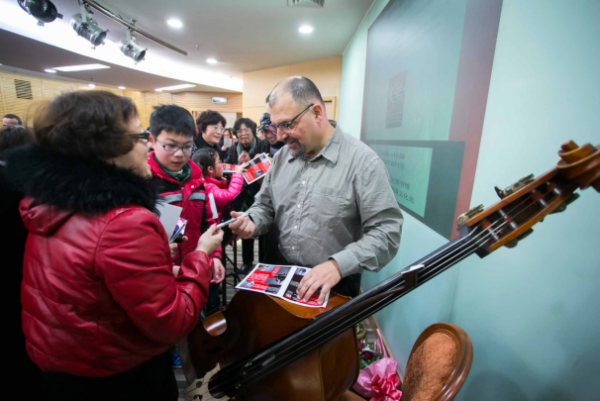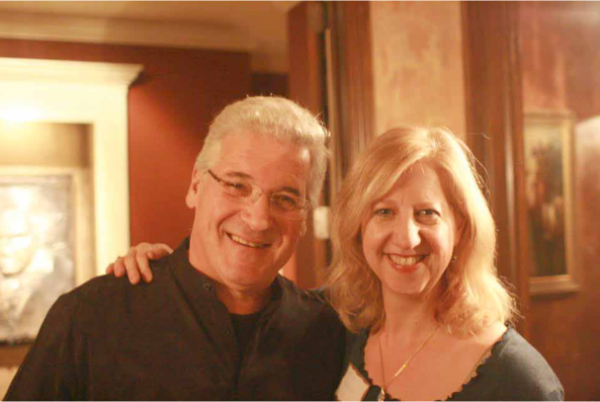Delegate Rachel Goldstein reports that the Chicago Symphony started a 19-day tour of Asia in late January. It included the cso’s first appearances in Taipei, Tianjin, and Seoul, as well as performances in Hong Kong, Shanghai, and Beijing. CSO members also participated in educational activities such as children’s concerts and master classes. Music Director Riccardo Muti was forced by illness to withdraw from the tour. Osmo Vänskä and Lorin Maazel stepped in to conduct the concerts, with a few changes to the planned repertoire. Maestro Muti is recovering from surgery and will return to Chicago in April.

CSO Musician Michael Hovnanian signs autographs following the Citizen Musician performance at the Xuhui Library in Shanghai. The free performance was open to a number of different groups, including visually impaired adults.
Todd Rosenberg
The October settlement that ended the five-week lockout of Indianapolis Symphony Orchestra musicians included both a bridge agreement, taking the ISO through February, and a five-year contract that would start after the successful completion of that bridge agreement. In order for that five-year contract to take effect, $5 million had to be raised between November 2012 and February 2013 from new sources — people who had never given to the ISO before, those who had not donated in two years, or existing donors who doubled their donation and made a five year pledge. On February 3, the ISO announced that it had more than met its goal, raising $5.4 million in new money and an additional $3.1 million from existing donors. The ISO board and management worked extraordinarily hard to accomplish this. Additionally, the musicians contributed to the fundraising effort in an unprecedented fashion by providing personal contact lists to the development department, selling a self-produced CD, sending personal letters to friends, family, and community members, and appealing to the audience association that was created during the five-week lockout.
According to delegate Louise Alexander, the musicians are excited to welcome ISO’s newly appointed CEO, Gary Ginstling, to their orchestra. Ginstling leaves a nearly five-year stint at the Cleveland Orchestra, where he served as general manager, and is slated to begin his new position on March 18.
The musicians of the Jacksonville Symphony have been “playing and talking” under management-imposed, union-contested terms and conditions (but no contract) since the opening of the 2012 season. An unfair labor practice charge over this imposition resulted in the nlrb issuing a complaint against the employer and setting a trial date for late March. The timing of the complaint was fortuitous, as it motivated the Jacksonville Symphony Association (JSA) to increase the amount of its imposed health insurance coverage. JSA has since offered a settlement proposal which would lengthen the season but offers a sliding bonus that is tied to increases in operating revenue in subsequent seasons. After the JSA hired former Chicago Symphony executive director and former president of the American Symphony Orchestra League (now League of American Orchestras) Henry Fogel as consultant, Mr. Fogel urged management to seek a trial postponement in the interest of increasing the likelihood of a settlement, as litigation would bring a chilling effect to that process. The trial is now postponed until the week of June 3. On March 3, the musicians responded to the settlement offer with their eighth proposal.
Meanwhile, the JSA board decided to institute a change in management, to take effect on March 18, tapping David Pierson, who served as executive director of the Jacksonville Symphony from 1988 to 1996, to replace Executive Director Stacy Ridenour. His new title will be CEO/President of the JSA.
The Houston Symphony has appointed Colombian-born, Vienna-trained conductor Andrés Orozco-Estrada as its next music director. Orozco-Estrada will serve as music director designate during Houston’s 2013–2014 centennial season and then begin a five-year contract the following season. He is currently the music director of the Tonkünstler-Orchester Niederösterreich (Vienna’s Tonkünstler Orchestra) and the Basque National Orchestra, and next year he will succeed Paavo Järvi as music director of the Radio Symphony Orchestra of Frankfurt. Orozco-Estrada has worked extensively with European orchestras, including Vienna Philharmonic, Munich Philharmonic, Leipzig Gewandhaus, Mahler Chamber Orchestra, City of Birmingham Symphony Orchestra, Santa Cecilia Orchestra Rome, Radio Symphony Orchestras of Frankfurt (hr) and Hamburg (NDR), and Orchestre National de France. His concert in Houston last October marked his U.S. professional orchestral debut and was so well received by the musicians that a visit for a private rehearsal with different repertoire was quickly arranged.
Brinton Smith, principal cellist and member of the search committee, says that the appointment concludes a three-year search that considered over 50 conductors and was notable for the deference paid by the board and the administration to the orchestral musicians’ preferences, as expressed in their evaluations. He adds that the musicians of the Houston Symphony wish to thank their ICSOM colleagues in other orchestras who aided the search by providing valuable feedback and insight regarding their guest conductors.
Last September, the Milwaukee Symphony Orchestra board of directors took the dramatic and unprecedented step of naming a musician, principal trumpet and Players Council chairman Mark Niehaus, to the position of executive director. In November the musicians and management agreed on modifications to the current contract that will delay raises due this year and spread them over a two-year contract extension. Since then, MSO committee chair Scott Kreger says that management has begun a campaign intended to raise both endowment and bridge funding, using cost containment and predictability as centerpieces of that campaign. One major effort that is meeting with some success is an attempt to accelerate the annual giving cycle to help end the long-standing practice of year-end emergency fundraising. Ultimately, the longer-term challenge is to eliminate the annual emergency by improving possibilities for earned income and raising the endowment to better match the orchestra’s budget. Other new initiatives have included a corporate holiday tour, which took the orchestra to a number of Milwaukee businesses for holiday concerts, and the acceleration of the cycle of planning and announcing seasons. The musicians of the orchestra are pleased that the Milwaukee Symphony Board and management are taking a positive approach to problems that many of us face.
The Cleveland Orchestra announced better than expected ticket sales, setting records in November and December 2012. Several factors contributed to the trend, including a wider variety of programming, a new student ticket advantage program, and an increased presence in social media.
According to delegate Jesse McCormick, the orchestra’s 2012 Holiday Festival ticket sales were 16% higher than its previous record set in 2007. Programming this year included Classical, Celebrity, and Traditional Holiday concerts, as well as a Charlie Chaplin film with orchestral accompaniment, premier performances of The Nutcracker with Joffrey Ballet, and a collaboration with Pink Martini.
The Cleveland Orchestra welcomed a much larger student audience in recent months. Students filled an average of 200 seats per concert. The orchestra rolled out new offerings for students, like the “Student Frequent FanCard” and the “Under 18’s Free” ticket program. The orchestra also increased its social media presence by over 300% in the past six months, including a dramatic increase of followers on Facebook and Twitter.
Following the bankruptcy and dissolution of the Syracuse Symphony Orchestra, SSO musicians organized Symphony Syracuse and, during the next 18 months, performed nearly 50 concerts under its auspices.
Though never intended to function long term, Symphony Syracuse did keep the orchestra in the public eye and focus attention on the situation. The desire for a long-term solution was shared by people from many parts of the community, so even while Symphony Syracuse was operating, leaders from higher education and other community members joined the musicians in trying to keep professional orchestral music in Syracuse permanently.
After extensive discussions, it was decided that a cooperative model would be adopted for the initial operations of a new orchestra to be run by Musical Associates of Central New York, a not-for-profit organization made up of nearly 50 musicians who were members of the Syracuse Symphony Orchestra. After securing funding commitments from the county and a foundation that had supported the Syracuse Symphony Orchestra, plans were announced to perform concerts through the fall.
The name of the new orchestra, Symphoria, was announced December 14 at the sold-out grand opening event. The organization also announced a subscription season for the winter and spring of 2013. Concerts have been very well attended, and Symphoria is repairing damaged relationships in the community.
Jon Garland recounts that ICSOM Chairperson Bruce Ridge was able to visit in December, just before Symphoria’s grand opening. Bruce was on hand to share Syracuse musicians’ experiences in anticipation of the event, and the musicians were likewise interested to hear Bruce relate the experiences of colleagues in other orchestras across the country. Jon adds that the support of ICSOM colleagues has been very meaningful to everyone and that they are very appreciative of all of the help, support, and advice they have received.

On December 2, 2012, the locked out musicians of the Saint Paul Chamber Orchestra presented a sold-out benefit concert with former music director Pinchas Zukerman to an enthusiastic crowd. Pictured are Pinchas
Zukerman and SPCO delegate Leslie Shank.
Tom Kornacker





